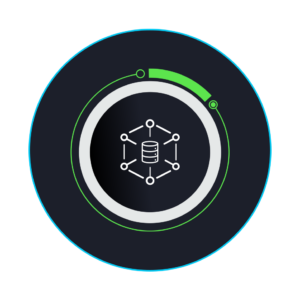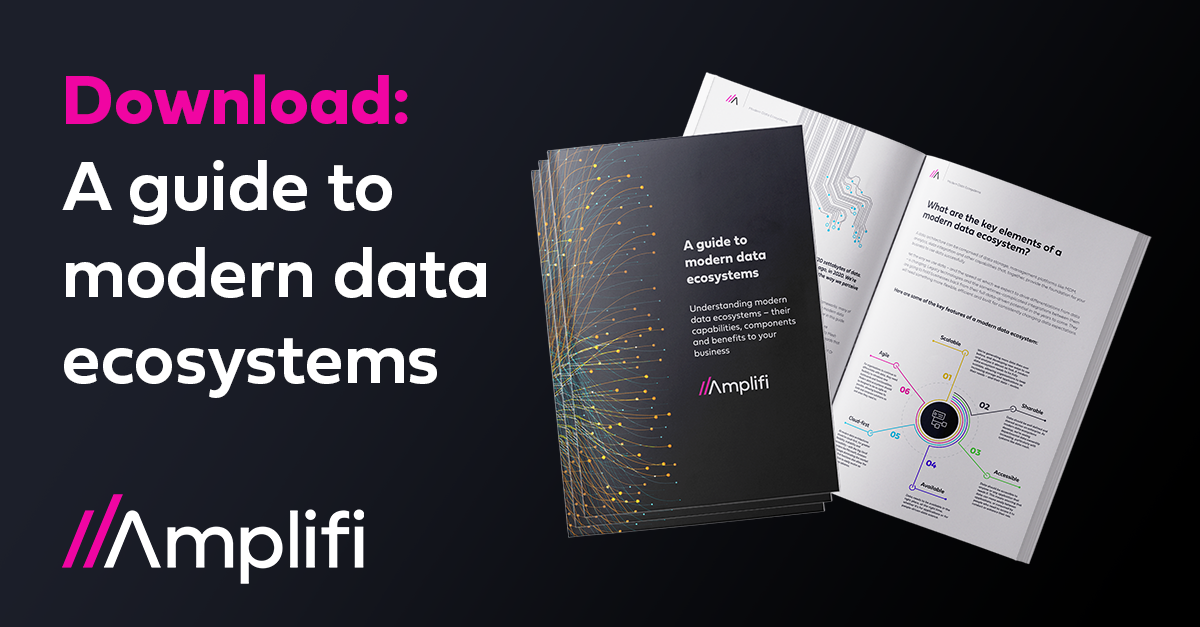We examine the anatomy of a modern data ecosystem and how to identify key capabilities in your existing technology stack.
Never mind the buzzwords – defining a modern data ecosystem just isn’t that simple. If you’re looking for a neatly packaged modern data ecosystem that you can integrate into your organization, the truth is there isn’t one, no matter what any vendor or consultancy might say otherwise.
 You might hear terms like ‘data mesh’ and ‘data fabric’ and become excited by the idea of a solution that can enhance your approach to data – a method that you can buy in that will transform how your organization handles, understands, and innovates with data. Yet in reality (at least, in the here and now) such an off-the-shelf solution doesn’t exist. A modern data ecosystem is simply an approach to organizing your data infrastructure. It’s a collection of capabilities and functions that modernize your business’ relationship with data, bringing better access, organization, and democracy to your digital information.
You might hear terms like ‘data mesh’ and ‘data fabric’ and become excited by the idea of a solution that can enhance your approach to data – a method that you can buy in that will transform how your organization handles, understands, and innovates with data. Yet in reality (at least, in the here and now) such an off-the-shelf solution doesn’t exist. A modern data ecosystem is simply an approach to organizing your data infrastructure. It’s a collection of capabilities and functions that modernize your business’ relationship with data, bringing better access, organization, and democracy to your digital information.
So, if a modern data ecosystem isn’t a buzzword, a software product, or a concrete framework that can be applied to your business, then what is it, and how can you benefit from it?
The Anatomy of a modern data ecosystem
As mentioned above, precisely defining a modern data ecosystem is impossible. It will never be finished: there will always be a new innovation, a new software, or a new function that can be added to further modernize any ecosystem, and part of the process is understanding those changes and your own changing needs as a business. However, as a collection of data-related capabilities, there are certain elements that can and should be embedded in a ‘modern data ecosystem’ today.
The following isn’t a comprehensive list, but breaks down some of the core elements that a data ecosystem today should include:
Core infrastructure
The platform that underpins your architecture, is usually cloud-based for modern data architectures.
Ingestion
The pipelines that import your data from multiple sources into your data storage.
Data storage
Whether it’s a Data Lake, Warehouse, Lakehouse, or several strategically placed data stores, this layer stores your data, ready to be accessed.
Data integration and Virtualization
This is the technology that enables consistent access to and delivery of data to where it’s needed: a critical part of a functioning data ecosystem.
Data access layer
This makes your data available to those who need it, including for operational reporting, APIs, Data Science, AI, Machine Learning, and operational reporting.
Data Governance and management
Your governance and management ensure that data, including metadata, is accurate, available reliable, secure, and recoverable. It also governs change control and serviceability, so that your stack can continuously and seamlessly evolve with your needs – a core principle of any modern data ecosystem.
Data Catalogue and Enterprise Knowledge Graph
The Data Catalogue creates an organized inventory of data assets in your organization, using metadata to help you manage your data, enabling better context, control, and collaboration. The enterprise knowledge graph relates the underlying data to real-world concepts and relationships.
Active Metadata
Truly modern data ecosystems treat metadata as a critical asset, continually monitoring and observing all aspects of it. By applying advanced analytic techniques to this metadata, the ecosystem is able to inform its own evolution.
Data security
Security is fundamental to any data architecture: with cyber threats growing, ensuring that security is built into your architecture is essential: including data masking, encryption, data erasure, and data resilience.
Modern Business Intelligence (BI) and analytics platforms
Analytics capabilities should be available to multiple personas across the organization, incorporating augmented analytics and support for decision intelligence.
Data Science and Machine Learning platforms
Data science and machine learning deliver business value by supporting the democratization of these functions across the organization, as well as decision intelligence, allowing all departments to extract value and insight from data.
Culture
Culture is important to any data initiative’s success, but when it comes to creating a modern data ecosystem, it’s even more essential. Successful modern data ecosystems hinge on how different aspects of the architecture are used and integrated together: making this work means having robust governance procedures throughout the business, ensuring that everyone understands their relationship to data and the importance of maintaining and utilizing the architecture effectively.
Democratizing data
As the profile of the workforce evolves, we’re also seeing a change in the data skills available across businesses. Rather than relying on small, central IT teams for data science and analysis, these skills are increasingly becoming embedded within the business functions that need them. Modern data architecture approaches seek to empower these people, federating and democratizing access to data across the team.
Note that these elements categorically aren’t specific software or technology. It’s more about looking at the bigger picture and identifying what solutions you need in your tech stack to enable certain key capabilities, such as shareability, scalability, accessibility, agility, and so on.
When looking to build your own modern data ecosystem, don’t be distracted by buzzwords that suggest you need a particular tech or platform to make it a success: you may already have a lot of what you need within your business. The key is assessing how they work together to deliver a full spectrum of services, not ripping it up and starting again.
The benefits of a modern data ecosystem
 Once you have these elements in play, what benefits should they bring to your business? One of the biggest advantages is that you should be able to act and react faster with data, enjoying more agility that allows you to respond to market trends, apply automation and speed up analysis and data science processes.
Once you have these elements in play, what benefits should they bring to your business? One of the biggest advantages is that you should be able to act and react faster with data, enjoying more agility that allows you to respond to market trends, apply automation and speed up analysis and data science processes.
Another is the democratization of data. As the world moves into an increasingly digital future, it’s not practical for data to be managed solely by centralized IT departments: every aspect of the business should be able to fuel decision-making with data. A modern data ecosystem in theory makes data more accessible and sharable, allowing every department the same opportunities to innovate and scale with data.
Scalability is also a key benefit. Yes, what defines a modern data ecosystem is always evolving – but by implementing any of the elements listed above you can make sure that yours always is, and that you have both the vision and functionality to keep scaling and changing how you manage your data.
Building a modern data ecosystem
If you’re looking to implement a modern data ecosystem, the first step is looking at what you want to achieve with your data, and identifying what you already have in place that enables those capabilities. By working with a partner like Amplifi, you can assess your technology against your ideal modern data framework, building a long-term strategy to provide flexibility and scalability with data.
For further insight into developing your ecosystem for the future, download Amplifi’s guide to modern data ecosystems.


